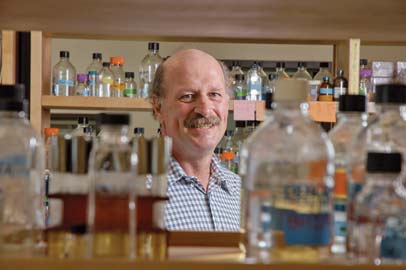Anatomy of a virus: A biological breakdown of H1N1
January 13, 2010 by Mitch Thompson

File Photo of Dr. Hancock (Courtesy of UBC Media Services)
Strange mutations, odd biological behaviour and the potential to become more deadly have catapulted H1N1, better-known as swine flu, into the scientific limelight.
With the threat of a more deadly version of the virus on the horizon, scientists are trying to understand how this virus came to be, and what it will become.
A team of UBC researchers has made interesting discoveries about H1N1 by studying a different virus: the one that causes avian flu.
The team has been studying how avian flu causes inflammation, and compared it with similar viruses, including H1N1.
“Intrinsically, swine flu doesn’t have the ability to cause inflammation as strong as avian flu,†explained UBC microbiology professor Bob Hancock.
Hancock described H1N1 as “somewhat less harmful and lethal than even the normal seasonal influenzas usually are.â€
However, the British Columbia Centre for Disease Control reports five deaths related to swine flu.
The cause of such deaths could be revealed by research Hancock’s team is doing into systemic inflammation.
“[The viruses] have on them… molecules that are recognized as ‘foreign’ by receptors inside cells, which turns on the inflammatory process,†said Hancock.
This process is a natural defense against these foreign objects, but the trouble comes when flu virus gets into the lungs. The inflammation that occurs can spell disaster if it continues for too long.
“Inflammation in the lungs… causes a lot of fluids to come into the lungs. People literally drown from their own fluids,†said Hancock.
In addition, the virus can worsen secondary infections and cause death, as shown by the 1918 Spanish Flu, which was also a form of H1N1. More than 20 million people died in that outbreak, according to the World Health Organization. Antibiotics had not yet been invented.
Seniors with age-related, health complications are vulnerable to flu-induced complications, but that may not be the case with H1N1.
“Elderly people have seen an H1N1 type virus before. I think the
last outbreak was in the ’70s,†said Hancock. “They tend to have some immunity to this virus…balanc[ing] off the sort of increased susceptibility.â€
A young, healthy person’s lack of existing antibodies may put them at higher risk than someone who was exposed in the past.
However, past exposure and the resulting antibodies don’t necessarily rule out infection, as the swine flu of 1918 and 1970 was not exactly the same as the swine flu of today.
“Flu has the ability to undergo a variety of processes that can change it…so that our body no longer recognizes it,†explained Hancock.
These changes of form are the reason people must be re-immunized every year.
Scientists use the system of H1N1 to categorize various flu strains by the sequence of hemagglutinin (H), the molecule that binds the virus to cells, and neuraminidase (N), the molecule that cuts free freshly made virus cells.
Some strains have similar sequences (swine flu is H1N1, avian flu is H5N1), so they are grouped together although they are biologically different.
The viruses categorized as influenza A, of which swine flu is one, generally have a hard time infecting humans, but H1N1 found a way to adapt itself to allow easy human-tohuman transmission.
“What it looks like is a farm worker managed to acquire two strains of influenza from pigs, and they went through a process known as reassortment,†said Hancock.
The two viruses swapped bits of each other until a new one was eventually created.
The union produced a certain strain that is easily transmitted between human beings.
“It’s really new, and people don’t really have an existing immunity,†he said. “There’s substantial concern that it could mutate in a way that would allow it to become more deadly.â€



Comments
Feel free to leave a comment...
For details on how we handle comments, select "Our Comment Policy" from the "About" drop-down menu at the top of the page.
Note: All comments are moderated and must be approved before they are published.